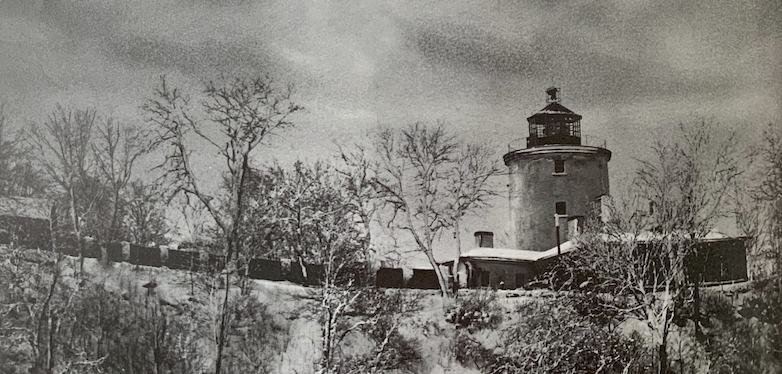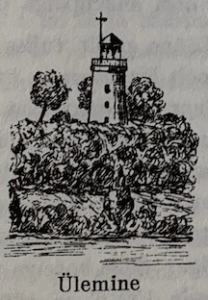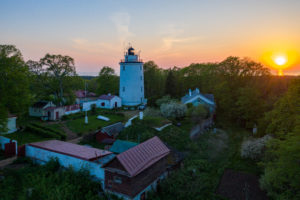Ancient historical records confirm that the government of the Russian Empire put so much focus on the waters of the Gulf of Finland, primarily because that is the area where the Empire’s naval fleet moved. In order to ensure safe navigation in the Baltic Sea for Russian ships, various seamarks were set up and lighthouses were built on the coastal regions of Estonia.
Early History
In 1759, one of the most renowned naval officers of the time, the Russian hydrographer Rear Admiral Semyon Mordvinov (1701–1777), gave a very detailed presentation to the Admiralty Board. The rear admiral drew the Admiralty Board’s attention to the fact that there were too few lighthouses in the Gulf of Finland and that the area, which saw many passing ships, had a multitude of islands, for example Odinsholm (Osmussaar), which unfortunately were not well visible, even during the day. The presentation also emphasised that there were many shallows, both in the sea and near the islands. At night-time during a storm the area was particularly dangerous for the squadron or commercial ships to navigate, as there was no way to shelter from the storm either in Tallinn or between Naissaar and Suurupi. Taking all of this into account, Rear Admiral Semyon Mordvinov proposed to have lighthouses built on the Suurupi peninsula and on Osmussaar. The Admiralty Board agreed with Mordvinov’s very professional project proposal, only amending it very slightly. The office of the chief commanding officer of Kronstadt was tasked with building the lighthouse in Suurupi, while the establishment of the other lighthouse was assigned to the Rogerwiek construction office, however, on Suur-Pakri instead of Osmussaar.
August Wilhelm Hupel. Topographische Nachrichten von Lief- und Ehstland, 1774. Hupel’s map of Tallinn Bay, which shows the rear lighthouse of Suurupi, finished in 1760.
The complete historical overview of the lighthouses of Russia, published in 2001 in Saint Petersburg references Admiral Alexey Nagayev’s publication Лоция или морской путеводитель (Pilot Book or a Guide to Seafaring). The navigational book hints at a rudimentary lit seamark already being on the cape of Suurupi in 1751. The 1789 publication does not include a description of the shape of the lighthouse, but Russian specialists speculate that in emergency situations a regular fire was burnt on racks in the shape of a basin or a basket. Fireplaces built of metal or stones were used for fire safety. A rack with concave edges somewhat prevented the sparks from an open fire from spreading.
1760 saw the completion of a 15.5-metre stone lighthouse on a high ledge of the plateau of Orava Village on Suurupi peninsula, with the height of its light at 40.8 metres from sea level. According to an old navigational manual, the warning light of the lighthouse could be seen from 13.3 miles away at the time.
By the end of the 18th century, the number of lighthouses in operation in Russia increased to sixteen, of which fifteen were situated in the Baltic Sea area. The navigational beacons were mostly kept lit by burning firewood or coal. The only exceptions were the Keri and Suurupi lighthouses, where candles were used in lanterns and oil or fat was burnt in lamps. [История… Том 1. Санкт- Петербург 1997, 449.]
By now we also have information on reconstruction details, including that in 1812 the limestone Suurupi lighthouse was fitted with a lantern room with a catoptric light composed of 15 lamps. The steel lantern room of this rear beacon sits on a stone truncated cone four storeys high. The height of the stone part of the lighthouse is 16.4 metres, the diameter at the base is 10 metres and at the upper part 9 metres. The rear occulting light of the leading light beacons can be seen from a distance of 15/12 nautical miles. The lantern room of the lighthouse has also been reconstructed many times over the years.
The fog siren station situated on the nearby Cape Ninamaa was operated from the rear beacon of the Suurupi leading lights. In 1898, a stone building was constructed for the fog siren station, with the pneumatic siren also fixed.
Suurupi endured multiple storms in 1824. During a raging rainstorm, the rear beacon of Suurupi was struck by lightning. The direct hit did not cause the massive seamark any significant damage, but lessons were learnt from the effects of the natural forces of a stormy summer. Similarly striking was the written order from Lieutenant General Leontiy Spafaryev to the lighthouse keepers in the Gulf of Finland. The hydrography officer’s instructions obliged lightning protection equipment to be installed on beacons in all lighthouse complexes. For this improvement to be perfectly legal, in addition to the signature of the hydrographer general, the order for equipping lighthouses with lightning-rods required personal approval from the Honourable Baron Bogdan Vasilyevich. The official letter ended with a reminder that His Highness must definitely be notified of the commencement of the installation of these safety devices.
According to an old pilot book, the height of the lighthouse of the Suurupi leading light was measured at 51 feet from its base at the time. The huge seamark was situated on the edge of the limestone plateau, 136 feet above sea level.
In 1827, heated disputes arose among the Empire’s maritime elite over how to use the urgently needed navigational marks to most effectively restrict the most dangerous reefs for shipping in the Gulf of Finland. The shallows of Tallinn and Kuradimuna (Develsei) were considered in particular. Leontiy Spafaryev, who was in charge of the lighthouses of the Gulf of Finland, recommended getting rid of the Suurupi lighthouse. The Russian hydrographer proposed to replace this by establishing a new seamark on Naissaar. The new lighthouse was meant to light a safe passage between the aforementioned shallows for seafarers. Admiral Gavril Sarychev did not agree with this proposal. He argued that,
‘The Suurupi lighthouse is quite necessary for sailors to reach the roadstead of Reval via the fairway between Suurupi and Naissaar. This task however cannot be solved by a lighthouse on Naissaar.’
The dispute resolution process ended up bringing hydrographer Spafaryev’s proposal to the relevant Admiralty Council in November 1827. After long negotiations, it was decided that keeping the existing Suurupi lighthouse was practical. In order to mark the shallow of Tallinn, a brand new lighthouse was to be erected on the underwater reef. Unfortunately, this decision had to be abandoned soon after.
Major renovation works on the Suurupi stone lighthouse were once again completed in 1858. A wooden dwelling was added to the lighthouse complex, along with a sauna was built near the tower for the lighthouse watchman’s family and associates, which is still there. Today this rarity can be seen and photographed by anyone interested.
It is obvious that a home was situated next to the lighthouse. Lighthouse watchmen or superintendents were important officers of the Admiralty Department in the 19th century, with 6-8 subservient. The superintendent rode a horse and was usually accompanied by a butler who shined their combat boots, lit up their pipe and provided other respectful services. By the way, the superintendent of Suurupi Lighthouse apparently had 7 dogs at the turn of the 20th century, which correlated with his/her important position.
Four decades later, the rear beacon and the lodge of the lighthouse complex underwent serious renovations. The daily living conditions of the lighthouse personnel were also taken into account, even at the level of very high-ranking public officials.
When the wooden lighthouse was completed on the bank of Suurupi channel in 1859, the Suurupi stone lighthouse became the upper lighthouse of Suurupi leading lights. Together, they showed the exit path from Tallinn Bay to the west. Read more about it here.
Maritime history confirms that the obligation to install lightning protection equipment began in Suurupi.
The relevant equipment was put to use after Suurupi lighthouse was struck by lightning during the stormy summer weather of 1842.
Archival documents on Suurupi lighthouse prior to World War I include original material from the years 1876–1880.
The written documents first referenced in this book also emphasise the great importance of the Suurupi leading lights at that time. The director of the Baltic Sea lighthouses and pilots, reporting to the Russian Ministry of the Navy, addressed the letter to the leader of the Governorate of Estonia. In his 9 June 1879 message, the rear admiral emphasised that a compartment boundary had been cleared in the coastal pine forest on the southern cape of Naissaar, which was of navigational importance. The letter notes that the cleared compartment boundary had unfortunately started to become overgrown due to the growth of young trees. Therefore, there was a need for the local governor to order the clearing of the forest compartment boundary that was of utmost importance from the point of view of maritime safety. The continued correspondence between high-ranking government officials revealed that this forested area was part of the private property of the peasant population of Naissaar. A letter from 28 February 1880 requests help from local authorities for gaining access to the private forest, once again for the purpose of clearing the compartment boundary in southern Naissaar. In a letter sent about six months later (19 August 1880), the rear admiral of the Ministry of the Navy informed the governor of Estonia that the clearing work in the forest compartment boundary in Naissaar would in effect commence on 24 August of the same year.
Later Growth
By the beginning of the 1900s, the lighthouse complex included the lighthouse supervisor’s residence, a stone building for fuel storage, a sauna, sizeable cellars and animal houses. The lighthouse complex was surrounded by a high fence.
The 25 November 1906 report No. 2520 by the head of the district of Reval informed the Baltic Sea lighthouse keepers of the required firewood procurement. Delivery and storage of the dry and valuable pine firewood needed for the Suurupi fog siren station, lighthouse and the Pakerort (Pakri) lighthouse complex cost 7 roubles per fathom at the market prices of the time.
During the first decade of the 1900s, the Suurupi lighthouse complex was added to the Reval (Tallinn) telephone network subscriber list.
The contemporary Merekalender (Sea Calendar) records the appearance of the lighthouse during the first decade of the previous century in detail: ‘48. Rear Surop. On N ledge of cape (59°28’–24°24’) 1 white S light – 13.3 m. White round stone tower. Visible from WSW to W and N until OtN1⁄2O. Fog siren. The light of this beacon in line with the light of the front beacon shows a safe passage to the roadstead of Tallinn (the line is NO-SW 66°). The fog siren on Cape Ninamaa sounds for 6 sec. Sounds every 1 min. 5 seconds. There is a telephone.’
We now know that a new prism apparatus by the famous Swedish company Gas accumulator was installed in Suurupi lighthouse in the spring of 1919.
The technical functionality of the lighthouse was far from perfect. The specialist magazine Laevandus (Seafaring) recalls an instance where the ‘weak’ sectors of our Russian Empire-era beacons turned out to be insufficient for ensuring navigational safety: ’“Weak” Sector of Pakri Lighthouse the Reason the English Steamboat Vasco Ran Aground near Suurupi in Autumn 1922’. [331 – Laevandus 1923, 11–12, 158.]
From 31 May 1925, this light delivery equipment was maintained by Jaan Einsok, former Tallinn lighthouse keeper who had been assigned as the machinist of Suurupi lighthouse, and Mikhail Grigoryev, who had been named as the lighthouse supervisor.
Prior to World War I, Suurupi peninsula was added to the defence system – Peter the Great’s naval fortress – that was situated on the Tallinn-Porkkala line and spanned from the Sõrve peninsula to the Åland Islands and from Tallinn to Kronstadt.
Three artillery and coastal defence batteries were planned for Suurupi. By 1917, two of the batteries and the branch line from Sõrve railway station were nearly completed, but much of what had been built was destroyed in February 1918 before the arrival of the Germans.
The Suurupi garrison commandant’s office of the Estonian Navy was positioned in the defence structures in 1927, which by then had been partially restored.
In 1937, after the reinforced concrete lighthouse on the northern tip of Cape Juminda had been completed, Armas Luige’s construction team, which had worked on the project, headed to Suurupi that same autumn, where a cribwork wharf was built for the Suurupi pilot station near the Ninamaa fog siren station. In addition, stone causeways and breakwaters were built for the harbour. In accordance with the Molotov–Ribbentrop Pact, the strategically important Suurupi battery territory was formally handed over to the Soviet Armed Forces on 6 July 1940.
A respectable seamark According to Lieutenant Colonel Johann Mey, the light of the rear white stone beacon of the Suurupi leading lights, which could be seen from a distance of 10 nautical miles, towered 40.8 metres above sea level, as noted in Eesti Loots (Estonian Pilot).
The lighthouse complex provided additional support to sailors with a signal station and a signal lamp. If needed, help was also available via the telephone for transmitting primary navigational information. On the neighbouring shore on the tip of Cape Ninamaa, there was a fog siren, and a ‘private pilot station’ was nearby. This information is from 1927.
Ten years later (1937), workmen led by structural engineer Armas Luige built a stone pier in Suurupi along with a proper wharf for pilot tenders. With this, opportunities for serving vessels visiting the harbours of Tallinn significantly improved for the pilot station located in the former officers’ mess of the coastal battery of Peter the Great’s naval fortress.
As of April 1939, the rear beacon of the Suurupi leading lights (valued at 84,200 Estonian kroons) was included among the property register of the Waterways Department, among a total of 22 leading lights. After the signing of the Soviet–Estonian Mutual Assistance Treaty, the small nation’s entire hydrographic service along with its lighthouses and naval fleet were lost.
The 1942 action plan of the German occupation-era Waterways Department notes the need for immediate repairs of the Suurupi, Mohni and Tahkuna lighthouses, which were situated by the waterways.
Prior to the arrival of autumn, the lighthouse department was busy with storing enough firewood in the lighthouse complexes for the winter period. ‘Otherwise we must take into account that the workers will leave the lighthouses,’ noted a letter from 1 August of the same year. Of the 722 cubic metres intended for the eighteen lighthouse families, the people of Suurupi required 100 square metres of decent firewood.
From 1812 until the last autumn of war in 1944, the lantern room with glass windows, positioned atop the bulky stone tower, remained intact. At the end of the Second World War, in September 1944 German troops left mainland Estonia. The retreating German forces were ordered to blow up significant lighthouses. “My great uncle’s wife Indi, who lived by the lower Suurupi lighthouse, had asked them, “Bitte, let the tower be, it is insignificant”, and they did,” said Anne-Ly Gross-Mitt retelling the story. The upper lighthouse, however, was scheduled for certain detonation and the charges were already attached, but the man who was tasked to do the deed was killed under suspicious circumstances. The tower caught fire and burnt out. The limestone lighthouse was burnt down in Suurupi and the lighthouse watchman’s house near it was blown up. The Germans set fire to the rear beacon of Suurupi as a strategic structure, which destroyed it from the inside. They also blew up the residence of the lighthouse keeper, which was next to the lighthouse. However, apparently one of the blasters flew himself/herself to the kingdom of heaven (or to hell?).
The torched lighthouse was built under the supervision of Elmar Kares (Suurupi lower lighthouse watchman), as well as Russian soldiers, as the lighthouses in the Soviet Union were military buildings. The burnt wooden partition ceilings were replaced by reinforced concrete ceilings supported on steel beams, and the staircase also received metal stairs. A service room was added to the existing limestone body, and a smaller lantern room was installed. The more modern light delivery equipment was connected to the general electric grid. Electricity became the new light source in 1946, replacing intermediate gas, but the work continued. By the way, the Suurupi lower lighthouse started using electricity 27 years later.
In 1950 a new home was built near the Suurupi upper lighthouse.
In 1951 a smaller diameter cylindrical floor was built on top of the former limestone tower and the lantern room was raised on its ceiling. Now the height of Suurupi lighthouse was 22 m above the ground and 66 m above sea level, because the tower is situated on a bank 44 m above the so-called Kronstadt sea-gauge.
The lighthouse keeper Elmar Kares was helped by his wife Indi, who took the role of electrician, and machinists Voldemar Katto and Ende Meri. After the experienced lighthouse keeper retired in 1978, the role was taken over by Peet Pajus, the husband of his niece Helle. The latter unexpectedly died in 1998. In the six years that followed, Helle Kares, as warden, was responsible for the operation of the Suurupi leading lights.
In around 1996, a seismograph was installed on a rigid foundation, which records severe earthquakes even in New Zealand or Hawaii and weak ones throughout Europe.
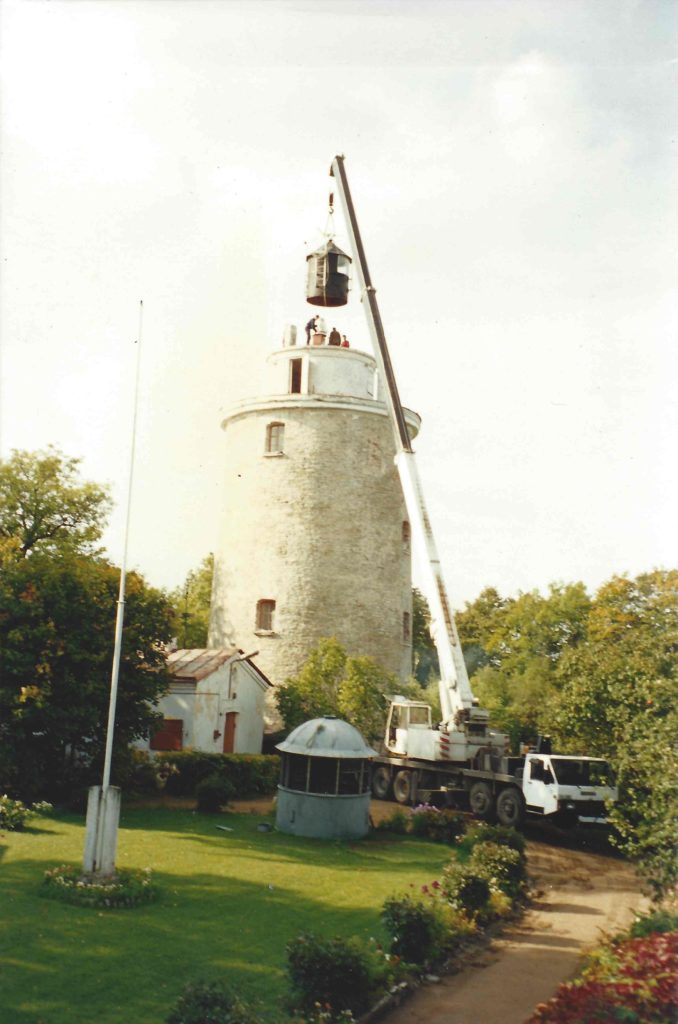
Suurupi Lighthouse Rear. 1998.
Until 1994, there was a Soviet Air Defence Forces communication unit on Suurupi peninsula. The year 1998 became symbolic. This was the year when repair works were performed in the rear beacon of the lighthouse complex and the lantern room that had served lighthouse keepers impeccably for nearly half a century was replaced with a new one. The previous lantern room continues its life as a worthy exhibit on the Estonian Maritime Museum’s viewing platform on the roof of Fat Margaret tower.
In 1937, a proper wharf and stone pier were completed for the pilot union that had been in private property on the shore. We are also led to the old and respectable Suurupi seamark that towers over the limestone bank by the writings of a well-known local. Pedro Krusten (actually Peeter Krustein, 1897– 1987) from Muraste manor warmly recalled the wonderful world that was kept alive in the lives, memories and spirits of the local coastal people as something of lasting value. ‘The lighthouse is right here behind a small clearing. They call it the red lighthouse, but it has been painted white, with only the roof remaining red.’ The trip to the lighthouse continues. ‘The tower presents a view to each direction. From here, we can now see even further than the horizon, as we have historical perspectives in front of us.’
From when they were built, the Suurupi lighthouses have had a very important role as navigational marks for many decades, ensuring safe passage for ships sailing along the Gulf of Finland. The leading lights of our northern coast have assisted shipmasters in accessing Tallinn Bay from the western side of the Gulf of Finland. The light of the rear beacon of Suurupi was clearly visible through the compartment boundary cut into the forest in the southern tip of Naissaar. The light of this beacon ensures a safe shipping route when entering Tallinn Bay from the east, lighting a safe fairway all the way to the signal lights of Jekaterinenthal (Tallinn’s leading lights).
Elmar Kares (born in 1918) was a lighthouse keeper after World War II who restored the rear beacon of Suurupi. He worked at the front and rear beacons of Suurupi lighthouse between 1950 and 1978. Hereby you may read more about Elmar Kares.
Recent History
During the times of the new Republic of Estonia, several devices appeared in the Suurupi upper lighthouse, which were not familiar to lighthouses back then. The lighthouse is equipped with the Land Board’s GPS station, which (of course!) allows you to locate positions both on land and at sea. There is also an extremely precise reference mark in the ground – a metal height mark used for levelling buildings and other structures, etc.
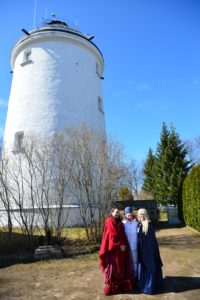
Suurupi Lighthouse Rear opening 2017
On Sunday, 30 April 2017, mainland Estonia’s oldest, Suurupi upper lighthouse, opened its doors to visitors. After many years the preparation process came to an end and Harku Municipality got its first tourist destination. Anne-Ly and Kristiina, the daughters of Helle Kares (last Suurupi lighthouse keeper), brought the lighthouse to life for people, who had grown up at the foot of Suurupi upper lighthouse. At the official opening, Tabasalu Music School’s Old Music Ensemble and Suurupi Female Choir “Meretule” performed. Guests included representatives of the Estonian Maritime Administration and the Estonian Lighthouse Society, the former Suurupi lighthouse keepers and representatives of the active associations of our municipality. The ribbon was solemnly cut, and everyone could revamp the lighthouse museum’s exhibits and enjoy the view from the 22-metre-high lighthouse balcony.
Hostess of Suurupi upper lighthouse welcomed visitors during the 2017, 2018 and 2019 tourist seasons. The lighthouse was open from Wednesday to Sunday from May to November.
In 2019, the Suurupi upper lighthouse complex was awarded the Estonian Beautiful Home Award by the Estonian President. The most beautiful heritage conservation object in 2019 Kristiina and Aivar Adamson’s Suurupi leading lights upper lighthouse. You may read more about it from news.
In 2020, Suurupi upper lighthouse, fuel storage facility and their registered immovable are owned by the Republic of Estonian Maritime Administration. The buildings around the upper lighthouse are owned by Helle Kares and Kristiina Adamson. The owner of the museum building and its registered immovable is NGO Suurupi Lighthouses.
 Suurupi.Travel
Suurupi.Travel 